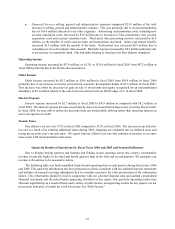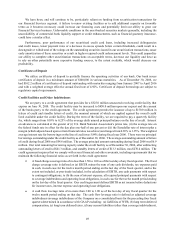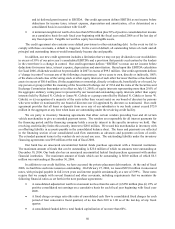Cabela's 2006 Annual Report Download - page 47
Download and view the complete annual report
Please find page 47 of the 2006 Cabela's annual report below. You can navigate through the pages in the report by either clicking on the pages listed below, or by using the keyword search tool below to find specific information within the annual report.
43
Delinquencies
We consider the entire balance of an account, including any accrued interest and fees, delinquent if the
minimum payment is not received by the payment due date. Our aging methodology is based on the number of
completed billing cycles during which a customer has failed to make a required payment. Delinquencies not only
have the potential to reduce earnings by increasing the unrealized loss recognized to reduce the loans to market
value and reducing securitization income, but they also result in additional operating costs dedicated to resolving the
delinquencies. The following chart shows the percentage of our managed loans that have been delinquent as of the
end of fiscal 2006, 2005 and 2004.
Fiscal Year
Number of days delinquent 2006 2005 2004
Greater than 30 days. . . . . . . . . . . . . . . . . . . . . 0.75% 0.67% 0.71%
Greater than 60 days. . . . . . . . . . . . . . . . . . . . . 0.44% 0.38% 0.41%
Greater than 90 days. . . . . . . . . . . . . . . . . . . . . 0.18% 0.16% 0.19%
Charge-offs
Gross charge-offs reflect the uncollectible principal, interest and fees on a customer’s account. Recoveries
reflect the amounts collected on previously charged-off accounts. Most bankcard issuers charge off accounts at 180
days. We charge off accounts on the 24th day of the month after an account becomes 115 days contractually delinquent,
except in the case of cardholder bankruptcies and cardholder deaths. Cardholder bankruptcies are charged off 30
days after notification, and delinquencies caused by cardholder deaths are charged off on the 24th day of the month
after an account is 60 days contractually delinquent. As a result, our charge-off rates are not directly comparable to
other participants in the bankcard industry. Our charge-off activity for the managed portfolio for fiscal years 2006,
2005 and 2004 is summarized below:
Fiscal Year
2006 2005 2004
(Dollars in Thousands)
Gross charge-offs . . . . . . . . . . . . . . . . . . . . . . . . . . . . . . . . . . . . . . . $31,068 $27,829 $23,134
Recoveries ............................................. 5,869 4,227 3,477
Net charge-offs ......................................... 25,199 23,602 19,657
Net charge-offs as a percentage of average managed loans . . . . . . . 1.86% 2.15% 2.21%
Liquidity and Capital Resources
Overview
Our merchandising business and our Financial Services segment have significantly different liquidity and capital
needs. The primary cash requirements of our merchandising business relate to capital for new destination retail stores,
purchases of economic development bonds related to the construction of new destination retail stores, purchases of
inventory, investments in our management information systems and other infrastructure, and other general working
capital needs. We historically have met these requirements by generating cash from our merchandising business
operations, borrowing under revolving credit facilities, issuing debt and equity securities, obtaining economic
development grants from state and local governments in connection with developing our destination retail stores,
collecting principal and interest payments on our economic development bonds and from the retirement of economic
development bonds. The cash flow we generate from our merchandising business is seasonal, with our peak cash
requirements for inventory occurring between May and November. While we have consistently generated overall
positive annual cash flow from our operating activities, other sources of liquidity are generally required by our
merchandising business during these peak cash use periods. These sources historically have included short-term
























